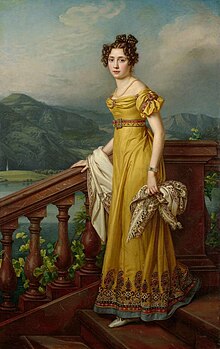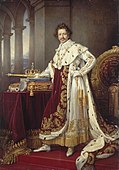The silhouette of men's fashion changed in similar ways: by the mid-1820s coats featured broad shoulders with puffed sleeves, a narrow waist, and full skirts. Trousers were worn for smart day wear, while breeches continued in use at court and in the country.
In France, after the death of Napoleon I, neo-classical style is abandoned and size gradually resumes its normal place. The style Restoration, Contemporary Biedermeier blooming elsewhere in continental Europe, characterizes the art under the reigns of Louis XVIII and his brother Charles X. Paris remains the capital of luxury. But the state of finances does not allow for large expenses.
The corset reappears and the skirt adopts the shape of a cone. The sleeves become more puffy and to make them even larger, they are doubled with cardboard, which has the advantage of making the size even thinner. Under Charles X (1825-1830), the skirts shorten the ankle and gain in volume. The hats take gigantic proportions, covered with feathers and ribbons. In the evening, the women are combing in height of a bun said in knot of Apollohairpiece maintained in balance by a large Spanish-style comb. Romanticism influences women's fashion.
As a pretext for feminine dress, men's fashion is always inspired by English chic: sober colors and shapes. The pants, legacy of the Revolution, is usually worn and the pants are abandoned little by little. One wears large capes and the top hat becomes the indispensable accessory of every self-respecting man until the First World War.
Women's fashions
Overview
During the first half of the 1820s, there were slight gradual modifications of Regency styles, with the position of the waistline trending successively lower than the high waistline of the Regency (just below the breasts), and also further development of the trends of the late 1810s towards giving skirts a somewhat conical silhouette (as opposed to earlier more clinging and free-flowing styles), and in having various types of decoration (sometimes large and ornate) applied horizontally around the dress near the hem. Sleeves also began increasing in size, foreshadowing the styles of the 1830s. However, there was still no radical break with the Empire/Regency aesthetic. Skirts became even wider at the bottom during the 1820s, with more ornamentation and definition toward the bottom of the skirt such as tucks, pleats, ruffles, or loops of silk or fur.
During the second half of the 1820s, this neoclassical aesthetic was decisively repudiated, preparing the way for the main fashion features of the next ten to fifteen years (large sleeves, somewhat strict corseting of the natural waist, full skirts, elaborate large-circumference hats, and visual emphasis on wide sloping shoulders). Rich colors such as chrome yellow and Turkey red became popular, and fabrics with large bold checkerboard or plaid patterns became fashionable, (another contrast with the previous fashion period, which had favored small delicate pastel prints). A bustle was sometimes also worn. Belts accentuated the new defined waist.
Dresses were often worn with a round ruffled linen collar similar to a soft Elizabethan ruff.
Hairstyles and headgear
Early in the decade, hair was parted in the center front and styled into tight curls over the temples. As the decade progressed, these curls became more elaborate and expansive. The bun on the back became a looped knot worn high on top of the head. Wide-brimmed hats and hat-like bonnets with masses of feathers and ribbon trims were worn by mid-decade.
Conservative married or older women wore indoor caps of fine linen descended from the earlier mob cap; these had a pleated or gathered caul on the back to cover the hair, and a narrow brim at the front that widened to cover the ears and often tied under the chin. These caps were worn under bonnets for street-wear.
Women also began to wear caps known as a cornette around 1816. These caps were tied under the chin and worn indoors. They also tended to be greatly adorned with plumes, ribbons, flowers, and jewels. Another alternative to the cornette was the turban, also often bejeweled and adorned, which shows the great interest in exotic cultures.
Outerwear
Shawls remained popular. Cloaks and full-length coats were worn in cold or wet weather.
Shoes
The fashionable shoe was a flat slipper. In the late 1820s, the first high shoe appeared and became vogue for both men and women. The shoe typically consisted of a three-inch high cloth top that laced on the inner side and a leather vamp that supported a long, narrow, and squared toe.
Style gallery

1-1823
| 
2-1823
| 
3 – 1824
| 
4 - 1824
| 
5 – 1825
|
|---|
1.Evening dress of 1823 features short puffed sleeves and is worn with a patterned shawl
2.Ruffled collar and sheer linen cap, 1823
3.Marchesa Marianna Florenzi wears a fur-trimmed dress with a belt over a white ruffled undergown and carries a feather-trimmed bonnet, 1824
4.This young lady wears a red gown with a satin waistband, accessorized with a paisley shawl, 1824.
5.The Duchess de Berry's fashion-forward gown of 1825 shows the wide waistband that was gradually lowering waistlines. Her fitted bodice and prominent headdress would be important styles for the next several years.
Men's fashions
Overview
By the mid-1820s, men's fashion plates show a shapely ideal silhouette with broad shoulders emphasized with puffs at the sleevehead, a narrow waist, and very curvy hips.
A corset was required to achieve the tiny waistline shown in fashion plates. Already de rigueur in the wardrobes of military officers, men of all middle and upper classes began wearing them, out of the necessity to fit in with the fashionable gentry. Usually referred to as "girdles", "belts" or "vests" (as "corsets" and "stays" were considered feminine terms) they were used to cinch the waist to sometimes tiny proportions, although sometimes they were simply whalebone-stiffened waistcoats with lacing in the back. Many contemporary cartoonists of the time poked fun at the repressed nature of the tightlaced gentlemen, although the style grew in popularity nonetheless. This was the case especially amidst middle-class men, who often used their wardrobe to promote themselves, at least in their minds, to a higher class — hence the dandy was born.
The emergence of wool as a primary fabric choice for men's outer garments led to a revolution in tailoring that allowed fit and finish to be of the utmost importance as opposed to ornamentation. This revolution allowed for an idealized classical silhouette to be materialized in men's fashion.
Shirts and cravats
Shirts of linen or cotton featured tall standing collars and were worn with wide cravats tied in a soft bow.
Coats and waistcoats
Around 1820, coats began to be made in an entirely new way. The tails and lapels were cut separately and subsequently attached to the coat. This ensured a better fit, a greater following of the body's contours, and more consistent positioning, even when the coat was unbuttoned. The tails themselves were narrow, pointed, and fell just below the knee. The shoulders were broad and the coat stood of the chest, yet was snug at the waist. Coats also were padded at the chest and waist. The collars and lapels were also padded in order to stiffen them. The collars were high and shawl-like in order to frame the face. Coats were cut straight across the waist. Waistcoats were buttoned high on the chest. Cutaway coats were worn as in the previous period for formal daywear, but the skirts might almost meet at the front waist.
Frock coats had the same nipped-in waist and full skirts. Very fashionable sleeves were gathered or pleated into a slightly puffed "leg of mutton" shape. Coats could be made of wool or velvet, and jewel colors like bottle green and midnight blue were high style. Double-breasted coats were very much in fashion throughout the decade.
Trousers and breeches
Trousers underwent a notable change in the 1820s. The new fit was a product of the French Revolution as it was considered uncouth to wear attire that looked wealthy. The length of the pant changed from below the knee to below the ankle and the fit of the pant loosened slightly from the first decade of the 19th century. The pants featured a small waistline and flared out slightly at the hip with small pleats, creating the image of fullness in the hip region. The introduction of straps that went under the foot, known as stirrup pants, also changed the shape and fit of these trousers.
Full-length light-colored trousers were worn for day; these were cut full through the hips and thighs, tapering to the ankles. They were held smoothly in place by straps fastened under the square-toed shoes. Dark trousers were worn for evening wear, and breeches were worn for formal functions at the British court (as they would be throughout the century). Breeches were also worn for horseback riding and other country pursuits, especially in Britain, with tall fitted boots.
Hats and hairstyles
Tall, silk hats again came into style. They were seen as a comfortable and light way to protect against sun and rain and were adequate for travelling and hunting. The crowns of tall hats also became curvy in keeping with the new style, and began to flare from the headband to the top. Curled hair and sideburns were fashionable.
Shoes
Rubber was introduced to Europe and America and created a shift in shoes from the pattens and clogs to the galosh. The galosh was soft and gummy in warm weather and hard and stiff in the cold. The style of men's shoes closely mirrored that of women's, as they were narrow, heelless slippers with low-cut vamps. They were very flimsy looking, as though they were held on by suction cups, for the leather barely covered the toes and hardly gripped the heel.
Style gallery

1-1828
| 
2-1826
| 
3-1820
| 
4-1820
| 
5 – 1826
|
|---|
1.This man wears a dark coat with a high shawl collar. His sleeves have puffs at the shoulder and taper to the wrist. He wears light brown trousers, 1828.
2.King Ludwig I in his Coronation Robes 1826
3.President James M97oe wears a120gh shirt collar and white cravat tied in a wide bow. His jacket collar and lapels form a continuous curve very like a shawl collar. 1820–22.
4.A portrait of Ludwig van Beethoven, 1820
5.Francisco de Goya wears a gray coat over a satin single-breasted waistcoat and a tall-collared shirt that reaches to his ears, with a white cravat. Spanish, 1826.
Children's fashion

1-1820
| 
2-1820
| 
3-1823
| 
4-1825
| 
5-1826
|
|---|
1.Mikhail Lermontov, Russia, 1820
2.Young boy's dress, Berlin, c. 1820
3.Princess Victoria of Kent, 1823
4.Portrait of Alwine and Robert Uellenberg by Heinrich Christoph Kolbe, Germany, 1825
5.United Kingdom, 1826
Source from Wikipedia
没有评论:
发表评论